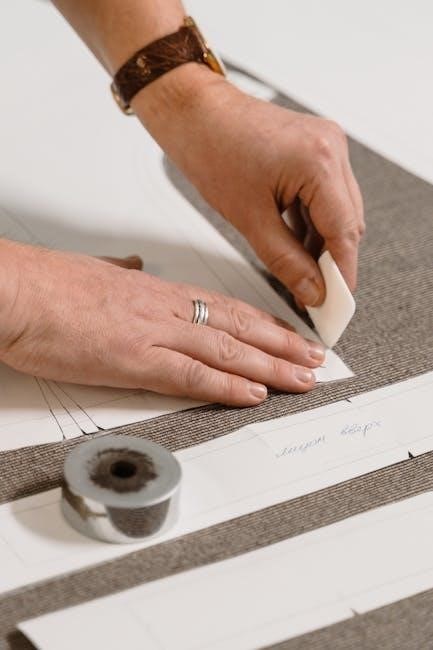
A men’s shirt size guide helps determine the perfect fit by considering chest, sleeve, and neck measurements․ Proper fit enhances comfort and style, ensuring shirts look tailored and feel great․
1․1 Understanding the Importance of Proper Fit
A proper fit is essential for both comfort and style․ A shirt that fits well enhances confidence, while an ill-fitting one can appear unflattering․ Poor fit issues, such as restrictive sleeves or excessive fabric, can disrupt comfort and aesthetics․ Ensuring the right measurements for chest, neck, and sleeves guarantees a tailored look and optimal comfort․ Prioritizing proper fit helps maintain a polished appearance, making it a cornerstone of dressing well for any occasion․
1․2 Overview of Shirt Sizes and Measurements
Shirt sizes are determined by key measurements: chest, neck, and sleeve length․ Universal size charts provide a standard reference, but variations exist between brands․ Chest size is measured around the fullest part, neck size around the base, and sleeve length from the shoulder to wrist․ Accurate measurements ensure the best fit, while understanding size charts helps navigate differences across brands․ This foundational knowledge aids in selecting shirts that align with personal comfort and style preferences․

How to Measure for a Men’s Shirt
Measure chest, neck, and sleeve length using a tape measure․ Chest is measured around the fullest part, neck at the base, and sleeve from shoulder to wrist․
2․1 Measuring Chest Size
To measure chest size, wrap a tape measure around the fullest part of your chest, keeping it level and parallel to the floor․ Ensure the tape is snug but not too tight, with your arms relaxed at your sides․ Stand upright and take a deep breath to ensure accuracy․ This measurement is crucial for determining the shirt size, as it ensures a comfortable and tailored fit․ Avoid slouching or holding the tape too loose, as this can lead to incorrect sizing․
2․2 Measuring Sleeve Length
To measure sleeve length, place the tape measure at the center back of your neck, extend it over your shoulder, and down to your wrist with your arm relaxed․ Ensure the tape is straight and your elbow is slightly bent․ This measurement determines the sleeve’s length for a comfortable fit․ Sleeve length preferences vary, with taller men often opting for longer sleeves and shorter men preferring shorter ones․ Accurate measurement ensures a balanced look with the shirt’s other dimensions․
2․3 Measuring Neck Size
To measure neck size, wrap a flexible tape measure around the base of your neck, just above the collarbone․ Keep the tape snug but not too tight, ensuring it’s parallel to the floor․ The measurement should be taken with the tape measure resting lightly on the skin․ Add about half an inch to the measurement for comfort․ This measurement is crucial for determining the collar size, ensuring the shirt fits comfortably around the neck without being too tight or loose․

Types of Fits for Men’s Shirts
Men’s shirts come in slim, regular, and relaxed fits, catering to different body types and preferences․ Understanding these styles helps choose the most flattering and comfortable option․
3․1 Slim Fit
A slim-fit shirt is tailored to fit closely to the body, offering a modern, streamlined appearance․ Designed for men with leaner builds, it features narrower sleeves and a shorter length․ This style is ideal for formal or semi-formal occasions, creating a sharp, put-together look․ Slim-fit shirts are popular for their contemporary aesthetic but require precise measurements to ensure comfort and avoid tightness․ They are a great choice for those seeking a fashionable yet sophisticated fit․
3;2 Regular Fit
A regular-fit shirt offers a classic, comfortable style with a slightly looser cut than slim-fit designs․ It is designed to suit most body types, providing ease of movement while maintaining a balanced appearance․ Regular-fit shirts are versatile, suitable for both casual and formal occasions․ They are ideal for those who prefer a traditional look without excessive tightness or bagginess․ This fit is particularly flattering for men with broader builds or those who value comfort in everyday wear․
3․3 Relaxed Fit
A relaxed-fit shirt offers a loose, comfortable silhouette with ample room through the chest and shoulders․ Designed for casual wear, it provides maximum ease of movement and a laid-back style․ Relaxed-fit shirts are ideal for men who prefer a non-restrictive fit or have broader builds․ They are perfect for everyday wear and layering without feeling tight․ This fit is great for those prioritizing comfort while maintaining a relaxed, effortless appearance․

Understanding Shirt Size Charts
A shirt size chart is a reference guide providing standard measurements for men’s shirts, including chest, sleeve length, and neck size․ It helps determine the best fit by comparing body measurements to the chart, though variations may exist between brands․
4․1 Universal Size Chart for Men
A universal size chart for men provides standardized measurements for shirt sizes, typically including chest, sleeve length, and neck circumference․ It serves as a reference to help men select the right fit based on their body measurements․ While variations exist between brands, a universal chart offers a general guide, ensuring consistency and ease in choosing sizes․ It is particularly useful for online shopping, where trying clothes before purchase isn’t possible․
4․2 Size Variations Between Brands
Shirt sizes can vary significantly between brands due to differences in cutting patterns and fit philosophies․ While a universal size chart provides a general guide, individual brands may have unique measurements for chest, sleeve length, and neck sizes․ Some brands cater to specific body types, such as slim or relaxed fits, while others may run smaller or larger than standard charts․ This inconsistency can make finding the perfect fit challenging, especially when shopping across different labels․

Dress Shirt vs․ Casual Shirt Sizing
Dress shirts typically have a more tailored fit, emphasizing precise chest and sleeve measurements for a formal look, while casual shirts offer a more relaxed sizing approach․
5․1 Differences in Measurements
Dress shirts and casual shirts differ in measurements due to their intended use․ Dress shirts require precise chest, sleeve, and neck measurements for a tailored fit, often with longer sleeves․ Casual shirts have a more relaxed fit, with looser chest and sleeve measurements, and shorter sleeve lengths․ These differences ensure the right balance between style and comfort for various occasions, making accurate measurements crucial for the perfect fit․
5․2 Fit Recommendations for Different Occasions
For formal events, opt for a slim-fit dress shirt with tailored measurements to ensure a polished look․ Business casual settings call for a regular-fit shirt with balanced proportions․ Casual outings are best paired with relaxed-fit shirts for comfort․ Consider the occasion’s formality and your personal style when selecting the fit․ Ensure the shirt aligns with your body type and the event’s dress code for a confident, put-together appearance․ Proper fit enhances both style and comfort, making it essential for any setting․

Common Challenges in Finding the Right Fit
Inconsistent sizing across brands and inaccurate measurements often lead to poor fit․ Sleeve length, chest, and shoulder measurements frequently cause issues, making it hard to find the perfect shirt․
6․1 Sleeve Length Issues
Sleeve length is a common challenge, as inconsistencies across brands can lead to shirts being too short or too long․ Proper measurement from the center back of the neck to the wrist is crucial․ Incorrect sleeve length can affect both comfort and style, making the shirt appear ill-fitting․ This issue is compounded by varying brand standards, which often result in sleeves that don’t align with body proportions, frustrating many shoppers seeking the perfect fit․
6․2 Chest and Shoulder Fit Problems
Chest and shoulder fit issues are common due to inaccurate measurements or inconsistent brand sizing․ A shirt that is too tight across the chest can restrict movement, while one that is too loose may look sloppy․ Shoulder fit is equally critical, as ill-fitting shoulders can throw off the entire silhouette․ Proper alignment of the shoulder seams is essential for a polished appearance․ Varying brand standards often exacerbate these challenges, making it difficult to achieve a balanced, comfortable fit․
The Role of Fabric in Shirt Sizing
Fabric type significantly impacts shirt sizing․ Stretch fabrics offer flexibility, while non-stretch fabrics maintain shape․ Understanding fabric properties ensures the best fit for different body types and preferences․
7․1 How Fabric Type Affects Fit
Fabric type plays a crucial role in how a shirt fits․ Cotton and linen offer a natural drape, while stretch fabrics like polyester blends provide flexibility․ Heavy fabrics hold their shape better, whereas lightweight ones drape loosely․ The weave and texture also influence fit, with tighter weaves offering structure and softer weaves allowing ease of movement․ Understanding fabric properties helps choose shirts that align with personal comfort and style preferences, ensuring the best possible fit․
7․2 Stretch vs․ Non-Stretch Fabrics
Stretch fabrics, such as those with elastane or polyester blends, offer flexibility and ease of movement, making them ideal for slim-fit shirts․ Non-stretch fabrics, like cotton or linen, provide a natural drape and structure but may feel less form-fitting․ Stretch fabrics adapt to body shape, while non-stretch fabrics rely on precise measurements for a tailored look․ Choosing between them depends on personal preference, lifestyle, and the desired aesthetic of the shirt․

Tips for Choosing the Right Size Online
Choosing the right shirt size online requires using detailed size charts, measuring accurately, and reading reviews for fit feedback to ensure the best possible fit and comfort․
8․1 Using Size Charts Effectively
Using size charts effectively involves comparing your body measurements to the chart provided by the brand․ Ensure accurate chest, sleeve, and neck measurements for the best fit․ Pay attention to fabric type, as stretch fabrics may fit differently than non-stretch․ Check for size variations between brands, as sizing can differ․ Use tools like size comparison charts to find the right fit․ Always refer to the specific chart provided for the shirt you’re purchasing, as measurements can vary by style and brand․
8․2 Reading Reviews for Fit Feedback
Reading reviews for fit feedback is crucial when shopping for shirts online․ Many reviewers share insights into how a shirt fits, such as whether it runs large or small․ Pay attention to comments about chest, sleeve, and neck measurements, as well as how the fabric affects the fit․ Reviews can also highlight differences in sizing between brands, helping you make a more informed decision․ This feedback is especially useful for ensuring the best fit without trying the shirt on first․
Resources for Further Guidance
Explore video tutorials, size comparison tools, and detailed guides from ASOS and Crew Clothing Company for precise measurements and fit advice, ensuring a perfect shirt fit․
9․1 Video Tutorials for Measurements
Video tutorials offer step-by-step guidance on measuring chest, sleeve length, and neck size․ They provide visual demonstrations, making it easier to understand proper techniques․ Many brands, like ASOS, share instructional videos to help users take accurate measurements․ These resources are especially useful for those new to shirt sizing, ensuring precise fit and reducing errors․ By following along with experts, men can confidently determine their size and shop with assurance․
9․2 Size Comparison Tools
Size comparison tools are essential for ensuring accuracy when shopping across brands․ These tools allow users to compare measurements and sizes from different retailers, reducing confusion․ Many websites, like ASOS and Crew Clothing Company, offer detailed charts and filters to help users find their ideal size․ By using these tools, men can easily identify their size range and make informed purchases, ensuring a perfect fit regardless of the brand or style they choose․
Accurate measurements and size charts ensure a perfect fit, boosting confidence and style․ Invest time in measuring and comparing sizes for a tailored look every time․
10․1 Final Tips for a Perfect Fit
For a flawless fit, always measure accurately and compare with size charts․ Consider fabric stretch, read reviews for real-world feedback, and try shirts on if possible․ Opt for tailored styles to enhance your physique․ Prioritize quality fabrics that drape well and ensure sleeves and hem align with your body proportions․ Confidence and style start with a shirt that fits perfectly, so take the time to get it right․
10․2 Importance of Accurate Measurements
Accurate measurements are crucial for selecting the right shirt size, ensuring comfort and a polished appearance․ Incorrect measurements can lead to ill-fitting shirts that are either too tight or too loose․ Always use a flexible tape measure and take measurements in front of a mirror for precision․ Ensure the tape isn’t pulled too tight or left too loose․ Properly measuring chest, neck, and sleeve length guarantees a flattering fit, making accurate measurements the foundation of a well-fitted shirt․
 bottom guide for sliding shower doors
bottom guide for sliding shower doors  harvest right troubleshooting guide
harvest right troubleshooting guide  tails noir trophy guide
tails noir trophy guide  san francisco travel guide map
san francisco travel guide map  antenna tv guide austin tx
antenna tv guide austin tx  act math study guide pdf
act math study guide pdf  king of the underworld rj kane pdf
king of the underworld rj kane pdf  merlin home transmitter manual
merlin home transmitter manual  contrat de sous-location québec pdf
contrat de sous-location québec pdf  mark cousins the story of film pdf
mark cousins the story of film pdf